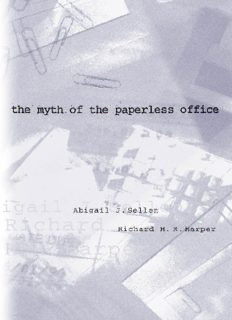
The Myth of the Paperless Office PDF
Preview The Myth of the Paperless Office
The Myth of the Paperless Office This page intentionally left blank The Myth of the Paperless Office Abigail J. Sellen and Richard H. R. Harper The MIT Press Cambridge, Massachusetts London, England © 2002 Massachusetts Institute of Technology All rights reserved. No part of this book may be reproduced in any form by any electronic or mechanical means (including photocopying, recording, or informa- tion storage and retrieval) without permission in writing from the publisher. This book was set in Sabon by Achorn Graphic Services, Inc. Printed and bound in the United States of America. Library of Congress Cataloging-in-Publication Data Sellen, Abigail J. The myth of the paperless office / Abigail J. Sellen and Richard H. R. Harper. p. cm. Includes bibliographical references and index. ISBN 0-262-19464-3 (hc. : alk. paper) 1. Office equipment and supplies. 2. Paper. I. Harper, Richard (Richard H. R.) II. Title. HF5521 .S43 2001 651.5—dc21 2001032626 For Christina, Harry, Stan, Ann, and John This page intentionally left blank Contents Acknowledgments ix 1 Introduction 1 2 What’s Wrong with Paper? 23 3 Paper in Knowledge Work 51 4 Reading from Paper 75 5 Paper in Support of Working Together 107 6 Designing New Technologies 139 7 The Future of Paper 185 Notes 213 References 219 Index 223 This page intentionally left blank Acknowledgments As with most research, there are many individuals who contribute but never see their name on the final product. Given that this work has been undertaken over a number of years and in different research establish- ments, there are many such people to thank. The institution that played the largest part in this work was Xerox’s re- search lab in Cambridge, England. It was here where we first met and com- menced the research; but it was here also where we met various other individuals who deserve a special thank you. Our erstwhile colleagues Marge Eldridge, Kenton O’Hara, and William Newman all played major roles not only as active researchers in various studies of paper but also as friends and advisers. Kenton, in particular, led most of the research on reading reported in chapter 4, and we are indebted to him for his work and insights. There were also many other people in the lab, at Xerox PARC in California, and elsewhere in the corporation, who influenced our thinking and provided the forum to develop our ideas. They include Bob Anderson (director of the lab in Cambridge), research colleagues Graham Button, Mik Lamming, and Allan Maclean, as well as support staff Michelle Hey- don, Christine King, and Mike Molloy. Outside of Xerox’s research labs, we are grateful to David Jones, who helped set up the research in the first place; Ted Carroll, who helped undertake it; Paul Ratcliffe, who encour- aged us to present it to the corporation; and Gene Golovchinsky, of Fuji Xerox, who has advised us on a variety of matters regarding e-books. Moving on to Hewlett-Packard Labs, Bristol, many other colleagues helped see the book through to completion. Draft chapters have greatly benefited from input from Barry Brown, David Frohlich, Erik Geelhoed, Alison Kidd, and Simon Lewis. The book would also never have been
Description: